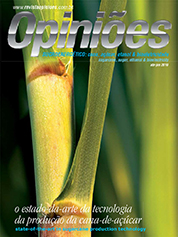Thiago Libório Romanelli
Professor of Energy Flow in Agricultural System at Esalq
Op-AA-24
Agricultural production from the energy viewpoint
Regarding the composition of the energy matrix, Brazil is a unique country, in that it obtains more than 46% of the consumed energy from renewable sources, which is far more than the global average of 12.7%, or even the 6.2% of developed countries. In 2007, for the first time in terms of renewable sources, hydroelectric generation lost its leading position in the country’s energy supply, given that sugarcane-derived products took over the role of major renewable energy source.
Sustainability is defined as the act of “meeting current generation needs without affecting the ability of future generations meeting theirs”, which entails considerable abstraction. It encompasses social, economic and environmental aspects, essentially relating to resource management, whether consisting of capital, labor or inputs, whereas the latter indirectly originate from natural resources.
Such factors are indirectly appraised when determining the production cost, however this is seldom so when considering the environmental perspective. In the international market, economic barriers are disguised as being social and environmental, requiring of agriculture that it supply food and energy, sufficient fiber to meet growing demand, without affecting the environment, furthermore being socially correct, while improving the trade balance.
It must be stated that to achieve all these targets at the same time is impossible, given that, notwithstanding its bucolic appeal, agriculture takes place in the fields and is associated with the greening inherent to photosynthesis, merely being a transformation unit of material and energy.
This is to say that agriculture is an open-air production unit. Therefore, one should not assign agriculture the responsibility of reverting adverse environmental impacts caused by all other sectors in meeting the demand for resources required to maintain urban standards of living. Upon accessing an agricultural production unit, several types of inputs used in the production process are incorporated to the end product, not physically, but rather in a depreciated form, as the result of having been employed in the production process.
Such directly consumed inputs (fertilizer, pesticides, and seeds) are specified by the a gronomic prescription itself, whereas fuel, machinery, infrastructure and labor are indirectly employed in making such inputs available to agricultural production units.
The intensification of production systems is accomplished by mechanization, a tool of great importance, given that through it production units gain access to inputs. The higher the efficiency of a mechanized set or a picker, the higher its operational capacity (ha/h) and the lower the consumption of indirect inputs per area, and hence, of agricultural production.
Furthermore, the quality of a mechanized operation is also essential. In our opinion, soil tillage of any specific crop must occur at a depth of 15 cm. If it is done at 10 cm, certainly the volume of soil into which roots will grow will not suffice. If it is done at 20 cm there will be unnecessary fuel consumption (greater tractive effort), and furthermore, one shall have lost the opportunity to work a larger area in a same time period. Sugarcane energy profitability, considering ethanol and bagasse, is 9.0 (2005/06 harvest), according to Macedo and others (2008). If electric power cogeneration is considered, this rate increases to 9.3.
Power consumption for agricultural production and transportation amounted to 210 MJ/t and 23.6 MJ/t for processing. Therefore, the energy balance (net energy) provided by a ton of sugarcane is 1951.4 MJ, or when considering one hectare, 169.8 GJ (87 t/ha). Monitoring how agriculture consumes natural resources and energy and how much energy it generates is essential for defining policies to foster the production in bioenergy sources and also to optimize the use of inputs.
Thus, accounting for the inflows and outflws of energy is a fundamentally important factor for improving the efficiency of a bioenergy source, identifying total demand, efficiency expressed by the net gain and the relation production/demand, in addition to the quantity needed to produce or process any given product.




